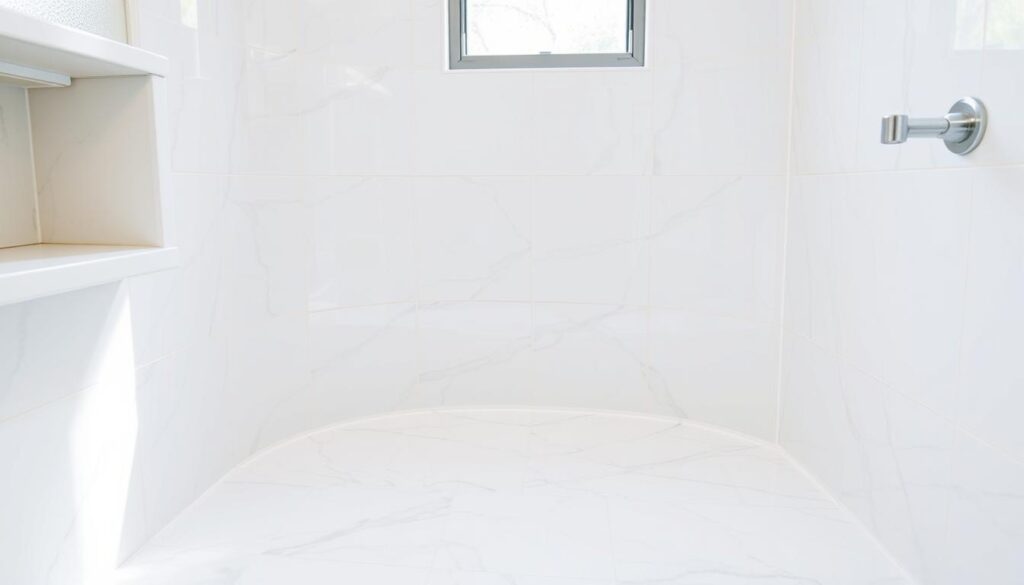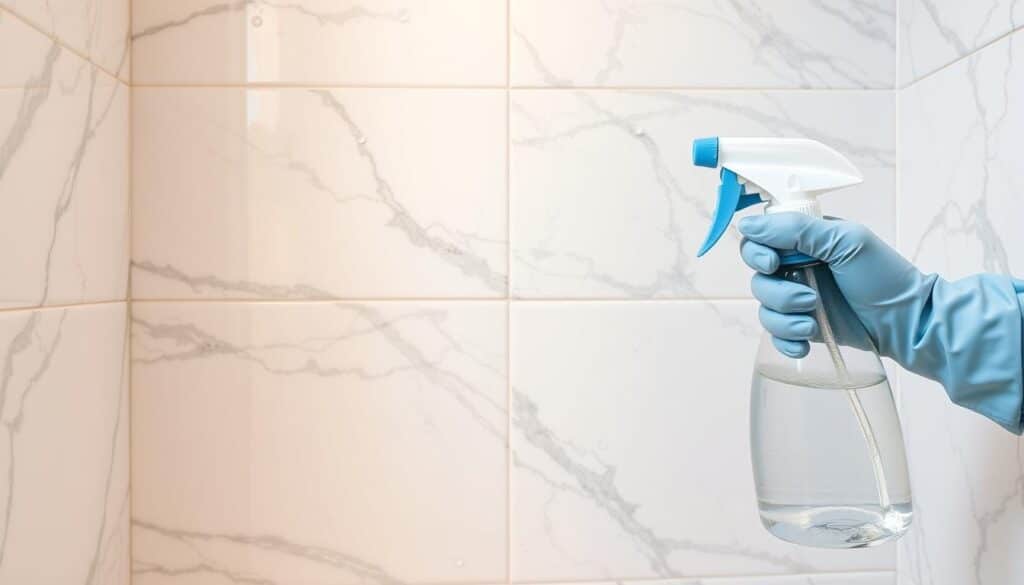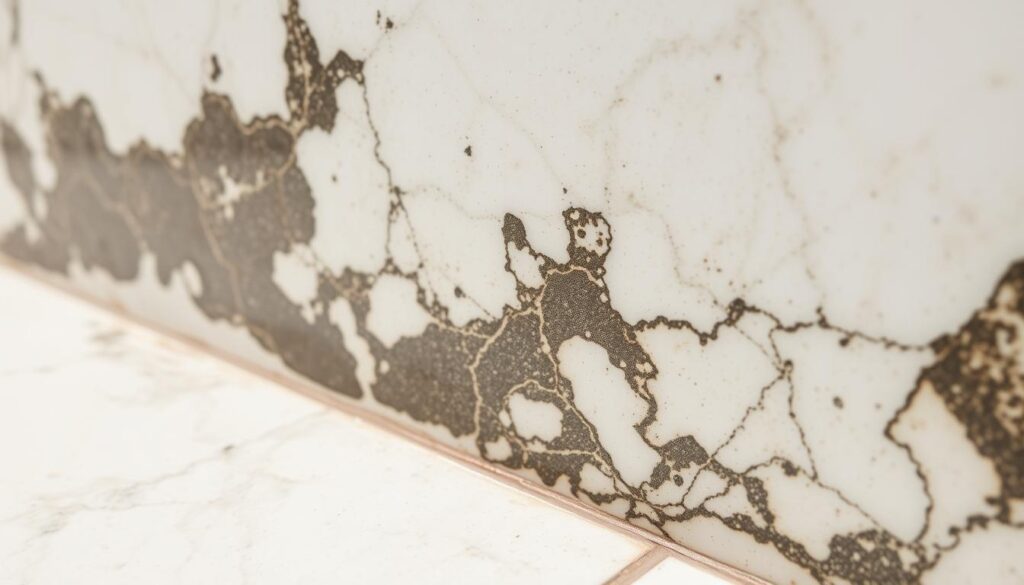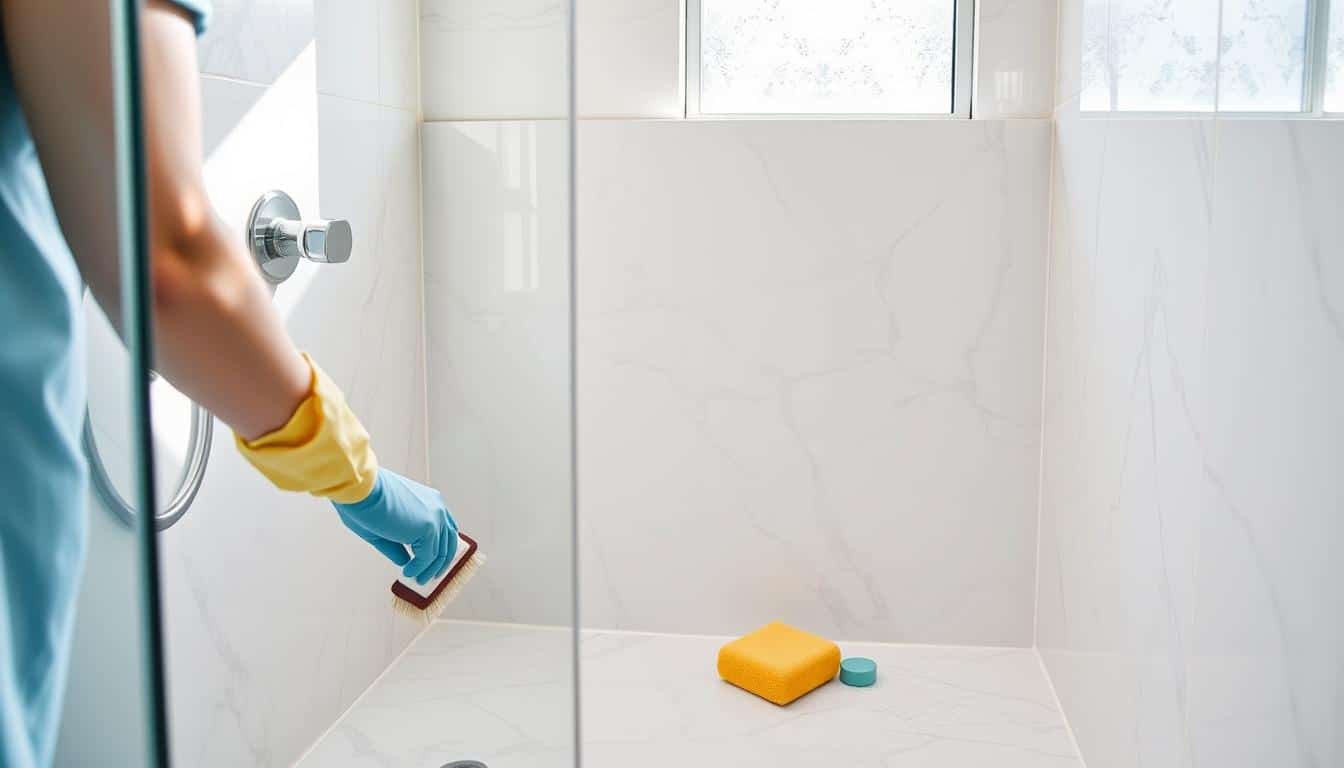Imagine stepping into your marble shower, only to see mold between the tiles. As a homeowner, I’ve faced this problem. But, I’ve found ways to remove mold from grout and stop it from coming back. In this article, I’ll share my effective methods to restore your marble shower’s beauty and cleanliness.
Marble is beautiful and durable, but it can get moldy because it’s porous. Soap scum, hard water, and moisture can cause mold in marble shower grout. If not treated, mold stains can ruin the look and be harmful to your family’s health.
But, with the right cleaning methods and products, you can fight mold in your marble shower. I’ll show you how to remove mold from grout and keep your shower mold-free. Let’s dive into the steps and tips for a clean marble shower.
Key Takeaways
- Marble is a porous material that can easily trap mold and mildew if not properly maintained.
- Effective mold removal requires a combination of cleaning solutions, scrubbing techniques, and preventative measures.
- Regular maintenance, including the use of mold-resistant products, is crucial for keeping your marble shower free of unsightly and potentially hazardous mold growth.
- Addressing mold issues promptly and thoroughly can help protect the long-term investment you’ve made in your marble shower.
- Seeking professional assistance may be necessary for severe mold infestations or complex marble restoration projects.
The Importance of Regular Marble Shower Maintenance
Keeping your marble shower in top shape is key to its beauty and value. Marble, being a porous stone, needs careful handling to avoid damage and stains. Regular upkeep can make your marble shower last longer and stay beautiful.
Preventing Mold Growth and Staining
Mold and mildew can harm your marble shower, affecting its look and health. Clean your shower with pH-neutral cleaners and dry it well after use. This stops soap scum and hard water from causing mold. Darker marble may only need to be resealed once a year, while lighter colors may require more frequent treatment.
Protecting Your Investment
Marble is a big investment, and proper care can keep its value high. Hiring a marble care professional may be necessary for extensive restoration work. But, regular cleaning and sealing can greatly help. By caring for your marble, you safeguard your investment and enjoy its beauty for many years.

| Maintenance Task | Frequency |
|---|---|
| Regular Cleaning | 2-3 times per week for heavily used showers, 1-2 times per week for less frequent use |
| Sealing | Darker marble: Once a year Lighter marble: Every 6-12 months |
| Professional Restoration | As needed for extensive damage or stains |
“Marble requires special care as it is delicate due to its stone nature. pH-neutral cleaners should be used for cleaning marble to avoid damage.”
Preparing for Mold Removal: Supplies You’ll Need
Before you start removing mold from your marble shower, make sure you have the right tools. This will help you do the job safely and effectively. You’ll need a gentle, pH-neutral cleaner for marble, a soft-bristled brush or cloth, baking soda, hydrogen peroxide, and protective gear like gloves and a mask.
It’s important to use a pH-neutral marble cleaner to avoid damaging your shower. Harsh chemicals can harm the marble, so choose a cleaner made for marble. Baking soda and hydrogen peroxide are great natural options to fight mold and remove tough stains.
Wearing gloves and a mask is key to protect yourself from mold spores. Mold can be dangerous if you breathe it in or touch it, so it’s important to stay safe while cleaning.
| Mold Removal Supplies | Purpose |
|---|---|
| pH-Neutral Marble Cleaner | Gently clean the marble surface without causing damage |
| Soft-Bristled Brush or Cloth | Agitate the surface to remove mold and grime |
| Baking Soda | Natural mold-fighting agent to lift stains |
| Hydrogen Peroxide | Effective in addressing mold and mildew issues |
| Gloves and Mask | Protect against exposure to mold spores |
With these essential supplies ready, you’re all set to remove mold from your marble shower and make it look new again.
How to Clean Mold from Grout in Marble Shower
Step-by-Step Guide for Effective Mold Removal
Keeping your marble shower mold-free is key to its beauty and function. Begin by mixing baking soda and hydrogen peroxide. This creates a paste to apply to moldy areas. Let it sit for 24 hours before scrubbing with a soft brush.
This method is gentle and safe for marble. It effectively removes mold without damaging the surface.
Safe and Gentle Cleaning Solutions
For tough mold spots, a small amount of acetone can help. But make sure to rinse it off well. Harsh chemicals or abrasive cleaners can harm marble. Instead, use a bleach and water solution in a 50/50 ratio.
Let it sit for at least 15 minutes before rinsing well. Keeping your shower dry and well-ventilated stops mold from coming back. After each use, squeegee water off and let it dry completely.
Regular cleaning and sealing also help. They create a moisture barrier that stops mold and mildew.

“Proper inspection of glass perimeters, damaged silicone, and worn-out plastic seal strips is crucial for preventing water infiltration in showers with glass enclosures.”
By using these step-by-step mold removal methods and gentle cleaners, you can keep your marble shower looking great for years.
Dealing with Stubborn Mold Stains
If you’re dealing with tough mold stains on your marble shower, it’s time for strong cleaning. A poultice cleaner, made from a cleaning agent and an absorbent, works well on these stains.
To use a poultice cleaner, apply the paste to the stain, cover it with plastic, and wait 24 hours. This lets the poultice pull out the stain from deep in the marble. After 24 hours, remove the plastic and rinse well. You might need to do this a few times to get rid of the mold stains.
Heavy-Duty Cleaning Methods
While poultice cleaners are effective, they can also etch the marble. This can make the marble look dull or hazy. To fix this, you might need to get a professional to polish or hone the marble to bring back its shine.
- Hydrogen peroxide at 3% can clean mold from white and gray-veined marble but might lighten darker marble.
- Testing 12% hydrogen peroxide is planned for tough stains, but it will start at half strength.
- Baking soda can be used to gently scrub grout between marble tiles, removing mold and grime.
- MarbleLife cleaner is very effective but hard to find and pricey.
Preventing mold is key to keeping your marble shower clean. Regular cleaning and sealing the marble can help prevent stains and keep your shower looking great.

“Proper sealant treatment on marble surfaces, if maintained with products like Granite Gold Sealer®, can help prevent mold formation and allow for easy cleaning with marble and granite shower cleaners.”
Removing Mildew and Preventing Future Growth
Dealing with mildew in your marble shower is as crucial as fighting mold. A diluted bleach solution can kill mildew and stop it from coming back. But, be careful with bleach since it can harm marble if not rinsed well. Always follow the instructions and rinse well after treating mildew.
To stop mold and mildew from being a problem, good air flow is essential. Make sure your bathroom has enough air by using an exhaust fan or opening a window. Also, wiping down surfaces with a squeegee after showering helps remove moisture and stops mold and mildew. If your bathroom is very humid, think about getting a dehumidifier to control moisture.
- Use a diluted bleach solution to effectively remove and prevent mildew growth
- Rinse the area thoroughly after using bleach to avoid damaging the marble
- Maintain proper ventilation by running an exhaust fan or opening a window
- Wipe down surfaces with a squeegee after each use to remove excess moisture
- Install a dehumidifier in highly humid bathrooms to control moisture levels
By taking these steps to remove mildew and stop it from coming back, you can keep your marble shower looking great. This ensures the long-term health of your valuable investment.
“Proper maintenance practices are key to effectively cleaning and preventing future mold and mildew issues in marble tile showers.”
Restoring the Shine: Polishing and Sealing Marble
After removing mold and mildew from your marble shower, it’s time to make it shine again. Polishing and sealing can bring back the marble’s beauty. It also keeps it looking great for years.
Professional Marble Restoration Services
If your marble is damaged or etched, get help from a professional. They can hone, polish, and seal your marble. This keeps it shiny and protects it from future problems.
Marble restoration services have a detailed process to make your marble shine:
- Honing: They gently grind the marble to remove imperfections and scratches.
- Polishing: They use fine abrasives to polish the marble, making it shine.
- Sealing: A sealant is applied to protect the marble from stains and water damage.
Choosing a professional for your marble shower ensures it’s cared for. This preserves its beauty and value.
“Regular maintenance and professional restoration can keep your marble shower looking like new for years to come.”
Proper marble restoration also fixes etching and mineral buildup. This keeps your shower in excellent condition.
To keep your marble shower shiny, clean it regularly, polish it, and seal it. Working with a trusted marble restoration service ensures your shower stays beautiful and functional for years.
Tips for Maintaining a Mold-Free Marble Shower
Keeping your marble shower mold-free is crucial for its beauty and life span. A few simple steps can help keep your bathroom healthy and mold-free. Here are some tips to prevent mold and keep your marble shower looking great.
Proper Ventilation and Moisture Control
Good ventilation is essential to stop mold in your marble shower. Make sure your bathroom has enough exhaust fans to remove excess moisture and humidity after each use. Also, think about getting a dehumidifier to keep the humidity between 30-50%.
Use a squeegee to wipe down your marble shower after each use. This helps remove standing water and control moisture. Also, check for any cracks or gaps in the grout or caulking. These can let water in and cause mold.
- Utilize exhaust fans or open windows to promote proper ventilation
- Maintain indoor humidity levels between 30-50% with a dehumidifier
- Wipe down surfaces with a squeegee after each use
- Inspect and seal any cracks or gaps in grout and caulking
By controlling moisture and ensuring good ventilation, you can greatly reduce mold and mildew. This keeps your marble shower looking new for many years.
Conclusion
Keeping a marble shower clean can be a bit tricky. But, with the right cleaning and care, it’s doable. This guide shows how to remove mold from grout and make marble shine again. It also helps prevent mold and mildew from coming back.
Always use gentle cleaners on marble, like vinegar or baking soda. For tough mold, try MB-9 Mold & Mildew Remover. Make sure the shower has good air flow to stop fungi growth. If mold stains are hard to get rid of, you might need a pro.
With some effort, you can keep your marble shower looking great. Regular cleaning and care will make it stay mold-free. Enjoy your marble shower for many years by following these tips.
FAQ
What supplies do I need to clean mold from grout in a marble shower?
To clean mold from your marble shower’s grout, you’ll need a few things. First, get a gentle, pH-neutral cleaner made for marble. You’ll also need a soft-bristled brush or cloth, baking soda, hydrogen peroxide, and protective gear like gloves and a mask.
What are the steps to effectively remove mold from grout in a marble shower?
To remove mold from your marble shower’s grout, start by mixing baking soda and hydrogen peroxide. Make a paste and apply it to the moldy areas. Let it sit for 24 hours before scrubbing with a soft-bristled brush.
Rinse well with water after scrubbing. For tough mold, a small amount of acetone can help. But make sure to rinse it off completely.
How can I prevent mold and mildew from recurring in my marble shower?
To stop mold and mildew from coming back, make sure your bathroom is well-ventilated. Use a squeegee to dry surfaces after each use. If your bathroom is very humid, think about getting a dehumidifier.
Also, seal your marble every year to protect it from stains and damage.
What should I do if I have stubborn mold stains on my marble shower?
If you have tough mold stains on your marble shower, you might need a poultice cleaner. This is a paste made from a cleaning agent and something absorbent. Apply the poultice, cover it with plastic, and let it sit for 24 hours before removing.
If the stain is still there, repeat the process. But remember, these strong cleaners can etch the marble. You might need a professional to polish or hone it to get the shine back.
When should I consider calling a professional for marble restoration services?
If your marble has big damage or etching from cleaning, call a professional. They can hone and polish the marble for you. They can also reapply a protective sealant to keep it shiny and prevent future problems.




